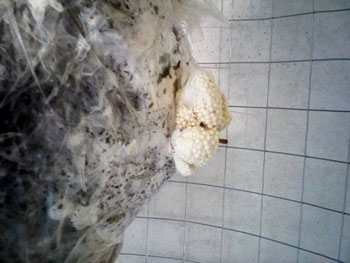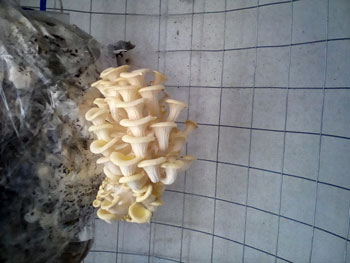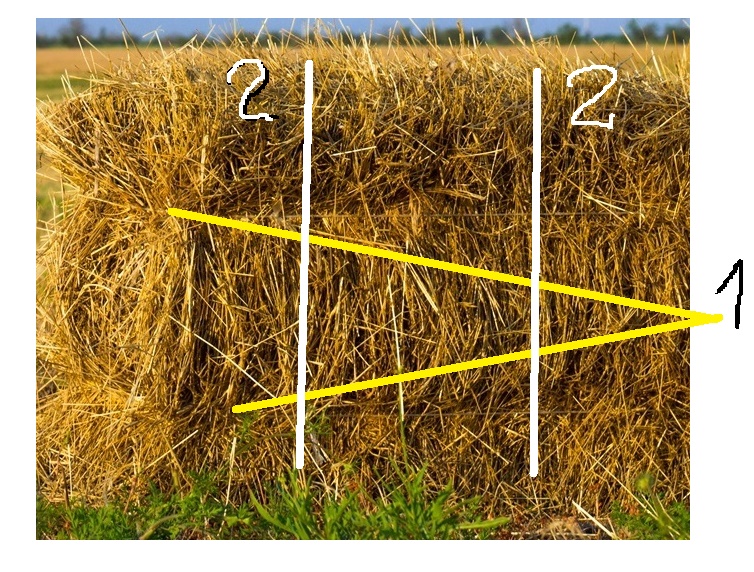
On my website and YouTube channel I talk about the methods of preparing the substrate that allow you to more or less efficiently rid it of trichoderma and bacteria.
I see that any experiments like "poured boiling water, mixed with grain" or "poured hydrogen peroxide into water, put straw there" end with a spoiled substrate. Therefore, I do not write about such methods, you can see them in huge quantities on the Internet.
But today I decided to deviate from my rule and publish my correspondence with a subscriber on the YouTube channel, which I run in Russian.
Further in the article - copied comments from a subscriber. The photos in this article are also from a subscriber. He later sent them to me by email.
Whether to try this method of preparing the substrate or not is up to you.
You can write by email, link at the bottom of the page.
User
@kotkot5452
I tried strain M5 (this is one of the strains of Pleurotus pulmonarius) at an air temperature of 24-25 degrees. A completely overgrown block does not fruiting until it receives a thermal shock of about 18-19 degrees for two nights. Primordia are formed very quickly, while the number of pins on them is minimal.
After thermal shock and the formation of primordia, the temperature was already 24-25 degrees, and the fruiting bodies grew very quickly, acquiring, due to their small number, quite impressive sizes. On the third or fourth day, the fruiting bodies acquire maximum weight at maximum size, while maintaining sufficient elasticity and strength.
Substrate - wheat straw.
Without sterilization. The straw was pre-soaked for 2-3 days directly in a bale, unpacked (bales weigh 10-12 kg). Then, in a clean ventilated room, it was left to lie for 5-7 days, drying out on the outside to a depth of 4-5 cm, maintaining a very high moisture deeper.
Afterwards, it was packed with grain spawn in high-density bags, tamped down and sent for overgrowing. Trichoderma was not observed, although I have a lot of it on the territory.
When dividing the bale ready for inoculation, the inner layers of the straw were noticeably exposed to the beginning of fermentation. The straw had a dark appearance and a characteristic slight smell of decay.


@veshenka-expert
Good day, thank you for the interesting story. You have a very unusual way of making the substrate. Do you always work like this? When the bales are left for 5-7 days, don't you separate them?
User:
No. I divide the bale just before inoculation.
I also intercept some of the bales with a rope in two additional places, across the ropes that tie the bale. And then I cut the ropes of the bale.
It turns out that the bale is divided into three small bales, without losing its original density acquired during packing by the combine.
To make it clearer how he divided the block, I will show this photo. The number 1 on it indicates the ropes with which the bale was tied in the field. The number 2 is the ropes with which this mushroom grower ties the bale.

In such cases, I inoculate with spawn by wedging the layers of straw, the resulting gap immediately slams shut. Due to the dense packaging, the substrate fibers are located close to each other, and the mycelium easily colonizes everything.
I make several inoculation points on different sides. In such cases, I pack not in a bag, but in packaging film on a rotating table, like at an airport.
Such bales have the shape of a parallelepiped and it is very convenient to stack them in a checkerboard pattern in racks with gaps so that they do not overheat.
I do not think that this is advisable for large, serious farms, but for those who grow for themselves it will be just right.
The bale, which after soaking showed very clear signs of fermentation, was not treated with lime, so as not to injure the microflora that formed there.
It had a rather pleasant smell, of rotten leaves, and as it grew, a sharp mushroom smell was added to it, and over time it became the main one, also quite pleasant.
Without a film, the straw will not dry out if you maintain a constant high humidity in the room. And besides, after the combine, the straw is very tightly packed, and the drying process is very slow in the deep layers. Trichoderma does not grow for quite objective reasons, it also needs an optimum for development.
And when the block grows in the dark, at a temperature of 22-24 degrees, there are many inoculation points, and also when the substrate has a fairly high level of nitrogen, and also good aeration, Trichoderma has a rather difficult time in such conditions. If, as a bonus to all this, the pH level is not less than 7, you can forget about trichoderma altogether. And even in tightly pressed bales, aeration still remains quite high, whole long straw works as a kind of air ducts.
@veshenka-expert
Can I publish your comments on my site? I'll indicate your nickname. I'll write that, well, there is such a way, whoever wants to - try it
@kotkot5452
No problem. In my experiments with the substrate, I am pursuing purely academic goals, the financial side of this issue is secondary for me.
As for the bales, I will also note that some of them, after soaking, were left for a week in the open air, simply on the concrete floor in the backyard, and several times during the time they were left, they were also wetted by rain. In other words, all willing contaminants had access to them.
At this stage, everything that grew in the surface layers was actively eaten by slugs, and a large number of earthworms gathered under the block itself, 90-95% of which were represented by the species Eisenia fetida.
